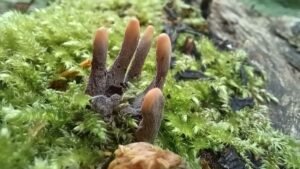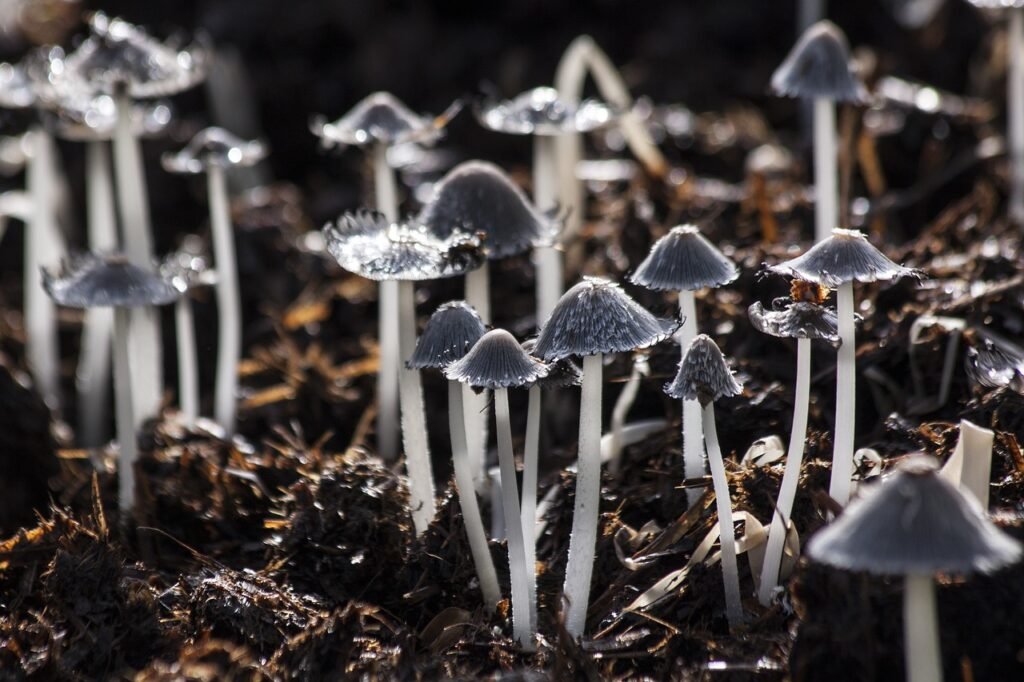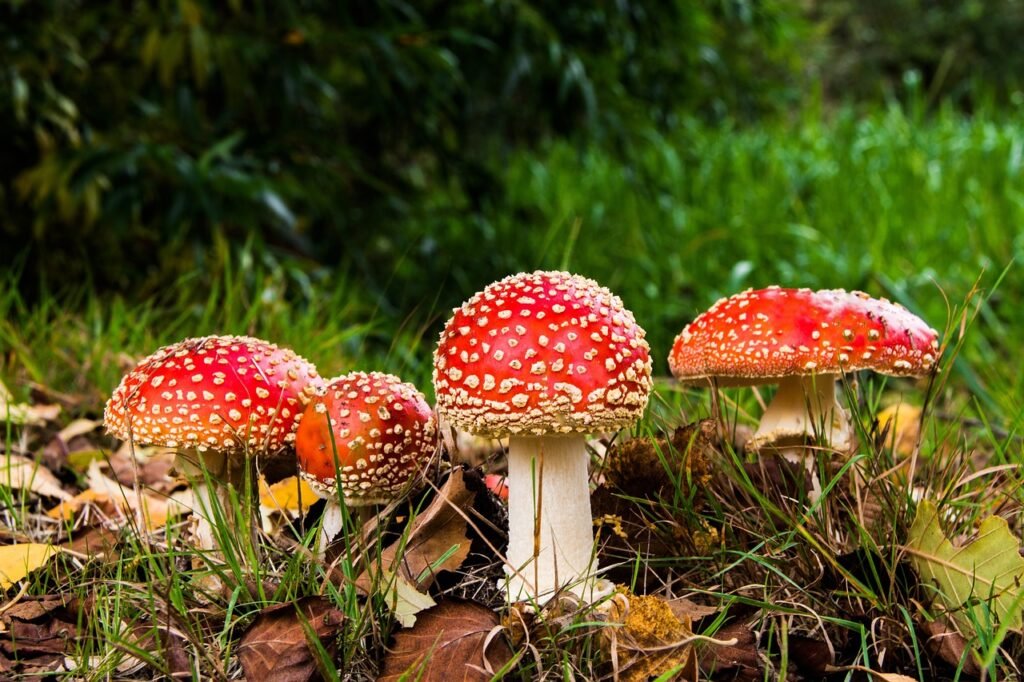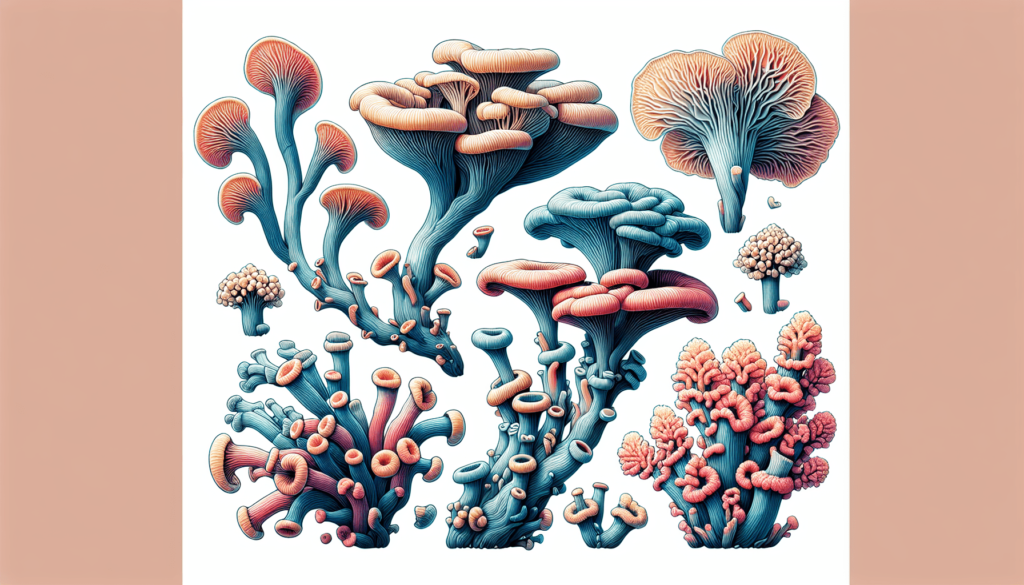In this captivating article, you will delve into the fascinating world of Xylaria polymorpha, a unique species known for its remarkable taxonomy and striking morphology. From its intricate classification to its varied physical forms, this comprehensive review provides an in-depth exploration of Xylaria polymorpha, shedding light on its captivating characteristics and capturing your imagination with its remarkable beauty. Prepare to be enthralled by the intricate details of this extraordinary organism.

Introduction
Overview of Xylaria polymorpha taxonomy and morphology
Xylaria polymorpha, commonly known as dead man’s fingers, is a fascinating and distinctive species of fungi that belongs to the Xylariaceae family. This fungus is known for its unique appearance, which resembles the fingers of a decaying corpse. In this comprehensive review, we will delve into the taxonomy and morphology of Xylaria polymorpha, exploring its classification, physical characteristics, life cycle, habitat and distribution, ecological interactions, medicinal properties, cultivation techniques, and the importance of research and study on this intriguing organism.
Taxonomy
Historical classification
The taxonomic classification of Xylaria polymorpha has evolved throughout history. Initially, it was classified within the genus Sphaeria due to its black, flask-shaped ascocarps. However, with advancements in genetic studies and morphological observations, it was later reclassified into the genus Xylaria. This reclassification was based on the examination of its ascospore characteristics and DNA analysis, which revealed significant differences from other members of the Sphaeria genus.
Current classification
Currently, Xylaria polymorpha is classified within the Xylariaceae family and the Xylaria genus. Within the Xylaria genus, it is further classified into the subgenus Xylaria, which includes several other closely related species. This current classification is based on not only the analysis of its ascospores and DNA, but also on its macroscopic and microscopic features, as well as its ecological and environmental preferences.
Genus description
The genus Xylaria is characterized by the presence of black, elongated ascocarps, commonly referred to as stromata. These stromata can vary in shape and size, with some species exhibiting finger-like or club-shaped structures, while others may have more irregular or fused forms. Xylaria species are typically saprophytic, deriving their nutrients from decomposing organic matter. They are commonly found in forested areas, often growing on decaying wood, leaf litter, or soil.

Morphology
Fruit body structure
The fruiting body, or sporocarp, of Xylaria polymorpha is composed of several elongated and cylindrical structures known as stromata. These stromata can range in size, from a few centimeters to more than 10 centimeters in length. Each stroma is comprised of multiple, finger-like projections that emerge from a common base. The tips of these projections often appear lighter in color, creating the distinct appearance of “dead man’s fingers.” The stromata are typically black in color, reflecting the mature spores contained within the asci.
Macroscopic features
Macroscopically, Xylaria polymorpha exhibits a striking resemblance to human fingers emerging from the ground or decaying wood. The stromata can vary in size, shape, and texture, with some appearing more elongated and slender, while others may be thicker and more irregularly shaped. The surface of the stroma is usually smooth, but it can occasionally be covered in a whitish or grayish powdery substance. On closer inspection, the individual fingers may appear segmented, with distinct articulations reminiscent of joints.
Microscopic features
Microscopically, Xylaria polymorpha displays unique features that contribute to its classification and identification. The asci, or sac-like structures that contain the spores, are typically clavate or club-shaped, with a narrow base and a wider apex. Each ascus contains eight elongated spores, often curved, with a distinct shape and ornamentation that aids in species differentiation. Additionally, the hyphae within the stromata show a dark coloration, and the presence of melanin pigmentation enhances the structural integrity of the fungus.
Life Cycle
Reproduction
The reproductive process of Xylaria polymorpha follows a typical fungal life cycle involving sexual reproduction. In the sexual phase, two compatible hyphae of different mating types fuse, forming a dikaryotic mycelium. This mycelium grows and develops within the substrate, eventually forming the stromata carrying the asci. Within the asci, the haploid nuclei of the dikaryotic mycelium fuse, resulting in the formation of diploid cells. These diploid cells then undergo meiosis, leading to the production of haploid ascospores, ready for dispersal and subsequent germination.
Growth and development
The growth and development of Xylaria polymorpha are influenced by various environmental factors, including temperature, moisture, and substrate composition. The fungus thrives in cool to temperate climates, with optimal growth occurring in moist and shaded habitats. After spore germination, hyphae grow and intertwine, forming an extensive mycelium within the substrate. As the mycelium matures, it begins to differentiate into stromatal primordia, which eventually develop into the characteristic finger-like projections. The fruiting bodies continue to grow until they reach their maximum size, at which point they release their spores into the surrounding environment.

Habitat and Distribution
Preferred habitats
Xylaria polymorpha exhibits a preference for specific habitats that provide suitable conditions for its growth and development. It is commonly found in forested areas, particularly in deciduous forests with a high presence of decaying wood and leaf litter. This species is often associated with mature hardwood trees, such as beech, oak, and maple, but it can also be found on fallen logs, rotting stumps, or buried wood. Xylaria polymorpha thrives in moist and shaded environments, where the substrate provides an ample source of organic matter for its saprophytic lifestyle.
Global distribution
Xylaria polymorpha is widely distributed across various regions of the world. It can be found in North America, Europe, Asia, and other continents, suggesting its adaptability to diverse climatic conditions. This widespread distribution is attributed to the ability of its spores to disperse over long distances, aided by wind, water, and various organisms. The presence of suitable habitats, such as forests and woodlands, contributes to the global prevalence of Xylaria polymorpha.
Regional distribution
Within its global distribution, Xylaria polymorpha may exhibit regional variations in abundance and frequency. In certain regions, such as parts of North America and Europe, it is commonly encountered and serves as a recognizable component of the local fungal flora. However, the exact distribution patterns can vary depending on factors such as climate, habitat availability, and ecological conditions. Further research is needed to provide a more detailed understanding of the regional distribution of Xylaria polymorpha.
Ecology and Interactions
Role in ecosystems
Xylaria polymorpha plays an essential role in ecosystem functioning due to its saprophytic nature. As a decomposer, it breaks down complex organic compounds present in dead wood and leaf litter, facilitating nutrient recycling and carbon cycling. By breaking down these materials, Xylaria polymorpha helps release nutrients back into the soil, making them available for other organisms. Furthermore, its presence contributes to the structural integrity of decaying wood, providing habitats and resources for a diverse range of organisms, including insects, bacteria, and other fungi.
Host interactions
Xylaria polymorpha interacts with various host organisms, primarily trees and plants. In its saprophytic lifestyle, it relies on dead or decaying organic matter as a source of nutrients. Therefore, it often associates with specific tree species and utilizes their decomposing wood as a substrate for growth and development. Xylaria polymorpha can colonize living trees, particularly those that are stressed or weakened, where it acts as a wound pathogen, infecting and exploiting the dead tissues. These interactions between Xylaria polymorpha and its host organisms contribute to the overall dynamics of forest ecosystems.
Predators and parasites
While Xylaria polymorpha serves as a decomposer and an integral part of forest ecosystems, it is not without its predators and parasites. Certain insects, such as beetles and flies, are known to feed on the stromata of Xylaria polymorpha, consuming the fungal tissues as a source of nutrients. Additionally, other fungi, including parasitic species, can infect and compete with Xylaria polymorpha for resources, potentially impacting its growth and reproductive success. These interactions create a delicate balance in the ecosystem, shaping the population dynamics and community structure within the fungal kingdom.

Medicinal Properties
Bioactive compounds
Xylaria polymorpha is a potential source of bioactive compounds with medicinal properties. Numerous studies have identified various chemical compounds isolated from this fungus, including terpenoids, alkaloids, and phenolic compounds. These bioactive compounds display a range of pharmacological activities, such as anti-inflammatory, antioxidant, antimicrobial, and anticancer properties, among others. The identification and isolation of these compounds contribute to the growing interest in Xylaria polymorpha as a valuable resource for drug discovery and pharmaceutical development.
Traditional uses
Throughout history, Xylaria polymorpha has been utilized in traditional medicine systems in different cultures. Indigenous communities in certain regions have employed this fungus for various medicinal purposes, including the treatment of wounds, infections, and respiratory ailments. Traditional healers and herbalists have attributed antibacterial, antifungal, and analgesic properties to Xylaria polymorpha and have used it in the form of poultices, decoctions, or infusions to alleviate symptoms and promote healing.
Potential therapeutic applications
The bioactive compounds isolated from Xylaria polymorpha hold great potential for various therapeutic applications. Their antimicrobial properties make them promising candidates for developing new antibiotics to combat drug-resistant pathogens. Additionally, the antioxidant and anti-inflammatory properties of these compounds may have potential applications in the treatment of chronic diseases, such as cardiovascular disorders and neurodegenerative conditions. Ongoing research aims to further explore the therapeutic potential of Xylaria polymorpha compounds and their possible contributions to modern medicine.
Cultivation and Culturing Techniques
Cultivation methods
Xylaria polymorpha cultivation has been achieved through artificial or controlled methods under laboratory conditions. These methods involve the inoculation of sterilized substrates with Xylaria polymorpha spores or mycelial fragments, followed by suitable incubation conditions. Various substrates, such as sawdust, grains, or synthetic media, are used to support the growth and development of the fungus. The use of sealed containers or specialized chambers maintains proper humidity, temperature, and ventilation, ensuring optimal conditions for the cultivation of Xylaria polymorpha.
Substrates for growth
Xylaria polymorpha exhibits versatile substrate preferences when cultivated. It can grow on a wide range of organic materials, including wood, agricultural waste, and various plant-based materials such as leaves or husks. The selection of a suitable substrate depends on factors such as the availability of the material, its nutrient composition, and the desired outcomes. Wood-based substrates are commonly used, as they mimic the natural habitat and support the growth of Xylaria polymorpha. However, ongoing research explores the use of alternative, sustainable substrates to enhance the efficiency and sustainability of cultivation practices.
Environmental conditions
The successful cultivation of Xylaria polymorpha requires careful consideration of environmental conditions. Optimal temperature and humidity ranges, typically between 20°C and 25°C and 70% to 80% relative humidity, respectively, create favorable conditions for growth and fruiting body formation. Adequate air exchange and proper ventilation within the cultivation chamber or container are essential to prevent the accumulation of excess moisture and the growth of contaminants. Light is not a primary requirement for Xylaria polymorpha cultivation, and in fact, it may hinder the development of characteristic stromata.
Research and Study Importance
Scientific research
Xylaria polymorpha continues to captivate researchers from various scientific disciplines. Its unique morphology, ecological interactions, and bioactive compounds provide numerous avenues for research. Scientists study the taxonomic relationships and molecular evolution of Xylaria polymorpha to gain a better understanding of its classification and phylogeny. Furthermore, investigations into its ecological interactions contribute to our understanding of forest ecosystems and the role of fungi in nutrient cycling and decomposition processes. The bioactive compounds found in Xylaria polymorpha attract attention as potential sources for drug discovery and biomedical research.
Taxonomic studies
The taxonomic classification and identification of Xylaria polymorpha are of paramount importance to mycologists and taxonomists. Accurate species identification helps to establish the evolutionary relationships and phylogenetic placement of Xylaria polymorpha within the fungal kingdom. Taxonomic studies employ both morphological and molecular approaches to distinguish between different Xylaria species, enabling the refinement and revision of species classifications. These studies contribute to the comprehensive understanding and documentation of fungal diversity and aid in the accurate identification of Xylaria polymorpha in both ecological and applied research.
Biotechnological applications
The bioactive compounds produced by Xylaria polymorpha hold significant potential for biotechnological applications. Their antimicrobial properties provide avenues for the development of new antibiotics to combat infectious diseases. Furthermore, the antioxidative and anti-inflammatory effects of these compounds may find applications in the pharmaceutical and nutraceutical industries. Biotechnological approaches, such as metabolic engineering and fermentation optimization, are being explored to harness the full potential of Xylaria polymorpha compounds and facilitate their production on a larger scale for commercial applications.
Conclusion
Summary of the taxonomic and morphological aspects of Xylaria polymorpha
In conclusion, Xylaria polymorpha, or dead man’s fingers, offers an intriguing case study within the field of mycology. Its taxonomic classification has undergone significant changes throughout history, reflecting advancements in scientific knowledge and understanding. Morphologically, Xylaria polymorpha exhibits distinctive fruiting body structures and macroscopic features that contribute to its recognizable appearance. Microscopically, the unique characteristics of its asci and spores aid in its identification and differentiation from other fungi species. Understanding the life cycle, habitat preferences, ecology, and medicinal properties of Xylaria polymorpha contributes to our overall understanding of fungal biology and provides potential avenues for future research and applications in various fields.
Overall, Xylaria polymorpha represents not only a fascinating organism in its own right but also a valuable resource for scientific exploration and discovery. Its taxonomy, morphology, life cycle, ecological interactions, medicinal properties, cultivation techniques, and research importance all contribute to a comprehensive understanding of this intriguing fungus. Continued research and study on Xylaria polymorpha will undoubtedly shed further light on its multifaceted nature and its potential applications in various scientific and industrial domains.
